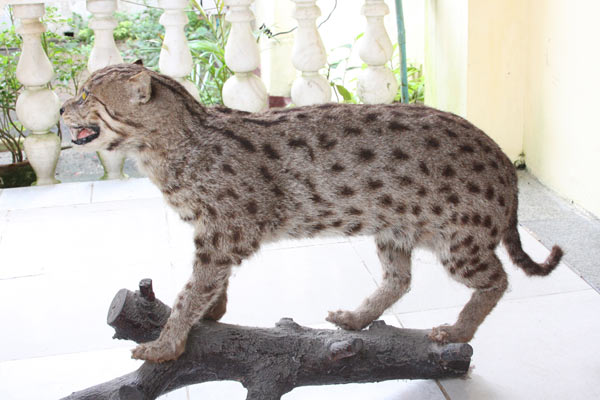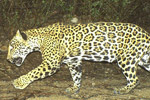Flat-headed cat and fishing cat require immediate research and conservation attention.
It’s no secret that when it comes to the wild cats of Asia—and, really, cats in general—tigers get all the press. In fact, tigers—down to an estimated 3,200 individuals—arguably dominate conservation across Asia. But as magnificent, grand, and endangered as the tigers are, there are a number of other felines in the region that are much less studied—and may be just as imperiled.
A new, special edition of Cat News from the IUCN’s Cat Specialist Group attempts to shine a light on Southeast Asia’s other cats: nine small-to-medium sized cats that are not a part of the big cat genus, Panthera. Of these nine, cat conservationists say two are in particular need of research and conservation attention: the flat-headed cat (Prionailurus planiceps) and the fishing cat (Prionailurus viverrinus).
Most of Southeast Asia’s cats have been studied in recent years using remote camera trap data in surveys set up for bigger cats, such as tigers and leopards, or other charismatic mammals. While these camera traps have revolutionized our understanding of some cryptic cats, like Borneo’s bay cat (Catopuma badia), which appears more common than long-believed. It has also meant that species not found in so-called tiger areas have been overlooked.
“There are still gaps in our understanding because most of the camera-trap data comes from forest habitats (where tigers predominate) rather than wetlands, streams, and scrub forest which are evidently the more preferred habitats for [the fishing cat, flat-headed cat, and jungle cat],” conservationists Christine Breitenmoser, Will Duckworth, and Antony Lynam told mongabay.com in a recent interview. “These species are conservation priorities largely due to their rarity and levels of threat faced. If there were lots of them still around, more should be turning up in trade but they are not.”

Fishing cat in Thailand. A new issue of Cat News finds that fishing cats and flat-headed cats require the most research and conservation attention of Southeast Asia’s smaller cats. Photo by: Passanan Cutter.

The bay cat: only found in Borneo this cat has long eluded scientists until recently. Photo by: Andrew Hearn and Jo Ross.
The biggest threat facing the region’s cat species is habitat destruction. Parts of Southeast Asia now have some of the highest deforestation rates on the planet—Indonesia and Malaysia—exacerbated by the rapid spread of monoculture plantations, such as oil palm, pulp, and rubber. Meanwhile, much of the human pressure in the region is focused on wetlands, key habitat for both the fishing cat and the flat-headed cat. Hunting is also worsening the situation.
“Small cats are not usually direct targets for poachers but they are collateral damage that gets caught in snare-lines along with other types of animals,” the scientists said. “For clouded leopards, favored prey species such as wild pig and muntjac are also subject to hunting for wild meat, so prey loss is additionally a key threat.”
So, how do we keep these cats around?
“Maintaining large tracts of forest habitat, keeping roads out of these places, and actively protecting them from poaching and other disturbances, should be a prescription for stabilizing populations for many wild cats,” the scientists say.
In an October 2014 interview, the authors of the introductory paper in the special issue told mongabay.com why these cats have been long neglected and what needs to happen to better understand and, ultimately, protect them.
INTERVIEW WITH CHRISTINE BREITENMOSER, WILL DUCKWORTH, AND ANTONY LYNAM

A mainland clouded leopard in Thailand. This is the region’s third biggest cat after the tiger and leopard. Photo by: Wanlop Chutipong.
Mongabay: Why should these nine cat species—those found in South East Asia not including tigers and leopard—be a higher conservation and research priority?
Christine Breitenmoser, Will Duckworth, and Antony Lynam: The smaller cat species are generally poorly known in terms of basic status and distribution. We know even less about their ecology, habitat preferences, and activity patterns. This is because there are few dedicated field studies while most of the information available comes from so-called ‘by-catch’ data from camera-trap studies done for the larger cats, especially tigers. This in itself reflects the dearth of available conservation funds for species that are not flamboyant, charismatic species with high commercial value. For these reasons, the smaller cats deserve more attention from conservationists and researchers.
While it is clear that there are no imminent threats of regional extinction to most of the species, three of them (one of which, flat-headed cat, occurs only in Southeast Asia) might well be seriously threatened. For two of these (flat-headed cat and fishing cat) the available information is too poor to know exactly where and how to deploy resources (assuming they could be secured) to conserve them. For the third species (jungle cat) one priority area is clear (northern Cambodia) but another area (dry-zone Myanmar) that might well hold large population is unsurveyed. In sum: without specific conservation measures in their favor, continued major declines in SE Asia are likely for these three species, and without greatly increased further research, any conservation measures may be inefficient and even ineffective.
Mongabay: How have camera traps revolutionized our understanding of South East Asia’s medium and small cats?
 This marbled cat in Malaysian Borneo is at home in the trees. Extensive use of trees makes getting accurate counts of some small cats more difficult. Photo by: Johan Embréus/Creative Commons 3.0. |
Christine Breitenmoser, Will Duckworth, and Antony Lynam: Wild cats tend to be hard to observe due to their secretive habits, because most of them live in dense tropical forests and are at least partly nocturnal and thus require specialized survey methods to detect them. It’s for these reasons that spotlighting and camera-traps are most useful survey methods for smaller cats. Camera-traps are remotely-triggered devices that are usually placed at ground level where they detect movements of all wildlife (and human) traffic passing in front of the beam. So camera-traps set for larger cats along trails at ground level have picked up the portion of smaller cat traffic that uses these same habitats. What they do not pick up—unless specifically set to do so—is the activity above the ground, or off trails, or in specialized habitats such as wetlands, open forest or scrubland. The three species of most conservation concern in Southeast Asia (flat-headed cat, fishing cat, and jungle cat) are all inhabitants of wetlands, open forest and scrubland. This is why they need specific research and conservation—it is not happening ‘on the back’ of the famous species.
Mongabay: Why should fishing cat and the flat-headed cat be made the conservation priorities of this group of nine species?
Christine Breitenmoser, Will Duckworth, and Antony Lynam: When we put all the camera-trap data together, we still find that for some species, such as fishing cat, flat-headed cat and jungle cat, there are still gaps in our understanding because most of the camera-trap data comes from forest habitats (where tigers predominate) rather than wetlands, streams, and scrub forest which are evidently the more preferred habitats for these species. These species are conservation priorities largely due to their rarity and levels of threat faced. If there were lots of them still around, more should be turning up in trade but they are not, and for all of them there are good a priori reasons based on habitat to assume major declines.
Mongabay: How might the chosen habitat of flat-headed cats and fishing cats make them much more vulnerable than other cats in the group?

Little panther? A melanistic form of the Asiatic golden cat in Myanmar. Photo by: WCS Myanmar Program.
Christine Breitenmoser, Will Duckworth, and Antony Lynam: Wetlands such as peat swamps are being reclaimed for oil palm in Indonesia and Malaysia. In Thailand coastal lakes are being converted for agriculture and aquaculture. Wetlands are foci of human settlement and activity so animals living in them must be tolerant of human activities. In most of Southeast Asia, non-specific hunting of mammals occurs wherever people live and go, so wetland species are typically particularly threatened if they are even somewhat susceptible to human hunting. And habitat loss is likely to be exacerbating outright reductions of populations of fishing and flat-headed cats by causing the animals to share smaller areas of habitat with ever-increasing numbers of people. For example, they need to forage more around human settlements where they end getting poached by people who worry about losing their chickens and captive birds.
The flat-headed cat is associated with wetlands and lowland areas. Its main threat is on-going transformation of forested areas to monoculture plantations, as the species seems not to be able to use these human-dominated habitats. Therefore it is very important for the long-term survival of flat-headed cats to conserve land near fresh-water rivers and peat swamp forests.
Mongabay: Why should we be less concerned about the jungle cat?
Christine Breitenmoser, Will Duckworth, and Antony Lynam: The jungle cat has a much wider distribution than the fishing cat and the flat-headed cat. It occurs across Asia over to Egypt and is very common in some parts of its range. The jungle cat is associated with wetland—habitats with water and dense vegetative cover, especially reed swamps, marsh, and littoral and riparian environments. However it evidently does not need such large complexes or contiguous areas as do fishing and flat-headed cats. Jungle cats can be found in a variety of habitats, ranging from desert (where it is found near oases or along riverbeds) to grassland, shrubby woodland and dry deciduous forest. They appear to do OK in disturbed habitats and scrub forests. In Indochina, they occur in areas with extensive deciduous dipterocarp forests with at least scattered surface water. In Lao and Cambodia, seasonal waterholes inside forested lands are being converted into economic land concessions for rubber. Presumably, this is a threat to the species in that part of its range.
Mongabay: The bay cat, found only in Borneo, has long been considered one of the world’s most cryptic cats. It was only photographed in 1997 and caught on video for the first time in 2009. So, why should recent research make us more hopeful for this species?

The incredibly elusive flat-headed cat in captivity. Photo by: © Carl Traeholt / Copenhagen Zoo.
Christine Breitenmoser, Will Duckworth, and Antony Lynam: It was formerly thought to be a great rarity. Camera-trapping has revolutionized understanding its distribution and habitat use. Today we know that the bay cat is widespread across Borneo except extreme lowlands with mangroves and swamp forests. The bay cat does not seem to use logging features, i.e. roads and trails, and might therefore be underrepresented in camera trap studies. Clouded leopard and marbled cat have higher probabilities of detection along logging features and skid trails for clouded leopard and marbled cat, where camera traps often are set.
Mongabay: How are the two species of clouded leopard faring?
Christine Breitenmoser, Will Duckworth, and Antony Lynam: The clouded leopard in Indochina has turned up in camera-traps widely in evergreen forest habitats across the range. From the limited ecological data we have clouded leopards appear to share Asiatic leopard’s preference for places with wild pig and muntjac suggesting they may be important as prey. There may be some level of incidental hunting in certain countries with hides of clouded leopards being traded in border markets (e.g. Thai-Myanmar, Lao-Vietnam, Myanmar-China) but otherwise it appears to be doing OK in places with stable forest cover.
The Sunda clouded leopard has a widespread distribution over a large portion of Borneo with the exception of South Kalimantan. As the species is closely associated with forest and with the current declining rate of suitable habitat the population is declining. So far it has not been confirmed in palm oil plantations.
Mongabay: What makes the leopard cat so resilient?

The acrobatic leopard cat gamboling in front of the camera. This species is the least endangered of Southeast Asia’s cats. Photo by: Ronglarp Sukmasuang.
Christine Breitenmoser, Will Duckworth, and Antony Lynam: The leopard cat is widespread and abundant and occurs in a wide variety of habitats. It is tolerant to habitat alteration and persists in human-dominated landscapes. It can use at least as part of its home range palm oil and rubber plantations where rats are common. Why it has this tolerance to disturbance, we don’t yet fully understand.
Mongabay: Why does hunting and snare hunting pose such a threat to these cat species? Are they caught in snares or do the snares and other overhunting kill off suitable prey?
Christine Breitenmoser, Will Duckworth, and Antony Lynam: Snaring is a technique used by poachers across Indochina, but especially in Lao, Cambodia, and Vietnam, and in neighbor countries where nationals of these countries are poaching (e.g. Thailand, Indonesia and Malaysia), and especially where demand for wild meat is high, and markets for wild meat exist, so poaching levels to supply the trade are relatively high, and where trade enforcement is weak.
Small cats are not usually direct targets for poachers but they are collateral damage that gets caught in snare-lines along with other types of animals. For clouded leopards, favored prey species such as wild pig and muntjac are also subject to hunting for wild meat, so prey loss is additionally a key threat.
Mongabay: What needs to be done to ensure these nine species are still around in a hundred years time? What are the most urgent priorities?

A golden cat in Thailand. Photo by: Shumpei Kitamura.
Christine Breitenmoser, Will Duckworth, and Antony Lynam: Maintaining large tracts of forest habitat, keeping roads out of these places, and actively protecting them from poaching and other disturbances, should be a prescription for stabilizing populations for many wild cats. For fishing cat that is evidently dependent on wetlands, protecting these places, and avoiding encroachment from human settlements or conversion for land development, are obvious priorities. For flat-headed cat more research is needed to understand what are the habitat preferences and sensitivities to disturbance, and therefore what needs to be managed to maintain the species.
Mongabay: Are there any countries or regions where conservation efforts are particularly needed to protect these species going forward?
Christine Breitenmoser, Will Duckworth, and Antony Lynam: Places where forest habitats and wetlands are at risk of wholesale conversion for agriculture, infrastructure development, and human settlement are clearly the places where conservation needs to be focused for all of the small cats, especially advocacy and engagement with policy-makers and land-use planners.
Mongabay: Southeast Asia’s rainforests are often viewed as some of the most imperiled and degraded the world over. Moreover, overhunting for consumption and traditional medicine has wiped out many animal populations, leading to ’empty forest syndrome’ in many parts of the region. Why should we still have hope for these cat species, given the current trends?
Christine Breitenmoser, Will Duckworth, and Antony Lynam: There is no evidence, yet, that hunting alone has led to loss of individual species of small cats. This is different for the large cats, where putative extinctions of tigers from Cambodia, and near-extinctions in Lao and Vietnam are examples of how targeted hunting can lead to a species being wiped out. Small cats don’t seem to be targeted for human consumption, and while large-scale snaring can lead to incidental killing, hunting is unlikely to be the main driver for species loss for any of the species.

Fishing cat in the Yangon Zoological Gardens. Photo by: Robert Tizard.
SOUTHEAST ASIA CAT SPECIES:
- Asiatic golden cat (Catopuma temminckii), Near Threatened
- Bay cat (Catopuma badia), Endangered
- Clouded leopard (Neofelis nebulosa), Vulnerable
- Fishing cat (Prionailurus viverrinus), Endangered
- Flat-headed cat (Prionailurus planiceps), Endangered
- Jungle cat (Felis chaus), Least Concern
- Leopard (Panthera pardus), Near Threatened
- Leopard cat (Prionailurus bengalensis), Least Concern
- Marbled cat (Pardofelis marmorata), Vulnerable
- Sunda clouded leopard (Neofelis diardi), Vulnerable
- Tiger (Panthera tigris), Endangered

A flat-headed cat caught on camera trap in Tangkulap Forest Reserve, Sabah, Malaysia. Photo by: Andreas Wilting/Creative Commons 3.0.

Mainland clouded leopard in Thailand. Photo by: Kate Jenks.

A marbled cat in Thailand. Photo by: Kate Jenks.

A bay cat in Borneo. Photo by: Andrew Hearn and Jo Ross.

A handsome leopard cat in Borneo. Photo by: Andrew Hearn and Jo Ross.

Asiatic golden cat in Myanmar. Photo by: WCS Myanmar Program.

Another color morph of an Asiatic golden cat in Myanmar. Photo by: WCS Myanmar Program.

The elaborately spotted marbled cat in Borneo. Photo by: Andrew Hearn and Jo Ross.

A taxidermy of a fishing cat from a souvenir shop in Yangon, Myanmar. While most small wild cats aren’t targeted by hunters, they are sometimes still killed. Photo by: Ag Myo Chit.
A Sunda clouded leopard near the lower Kinabatangan River in Sabah, Malaysian Borneo. Photo by: Paulo Philippidis/Creative Commons 3.0.
Related articles

(10/02/2014) For thousands of years the jaguar was a God, then it was vermin to be destroyed, and today it is the inspiration for arguably the most ambitious conservation effort on the planet. A new book by renowned big cat conservationist, Alan Rabinowitz, tells this remarkable story from the jaguar’s evolutionary origins in Asia to its re-emergence today as a cultural and ecological symbol.
Malayan tiger population plunges to just 250-340 individuals

(09/16/2014) Malaysia is on the edge of losing its tigers, and the world is one step nearer to losing another tiger subspecies: the Malayan tiger. Camera trap surveys from 2010-2013 have estimated that only 250-340 Malayan tigers remain, potentially a halving of the previous estimate of 500 individuals.
Meet the newest enemy to India’s wildlife

(09/11/2014) A boom in infrastructure and population has forced India’s wildlife to eke out a creative existence in an increasingly human-modified environment. Big cats such as the leopard are often spotted within large cities, on railway tracks, and sadly, on India’s burgeoning and sprawling road network.

(08/22/2014) Every year, between 20 and 30 tigers are poached. Illegal logging is reducing the tigers’ habitat, and illegal hunting is reducing its food supply. However, these are not the only threats to wild tiger survival — other problems are cropping up and taking a toll on the iconic big cat.
Logging of Russian Far East damaging tiger habitat, few intact forests protected (Part I)

(08/19/2014) The destruction of Russian forests to supply timber to international markets is becoming one of the biggest threats to the world’s largest cat, the Siberian tiger. Russia has more forests than any other country, with more than half of the world’s coniferous forests. However, worldwide demand for high quality timber, along with weak regulations, has led to widespread logging of Russia’s trees.
Seeking justice for Corazón: jaguar killings test the conservation movement in Mexico

(07/31/2014) Eight years ago, a female jaguar cub was caught on film by a motion-triggered camera trap set in the foothills of canyons, oak forest, and scrubland that make-up the Northern Jaguar Reserve, just 125 miles south of the U.S.-Mexico border. Three years later, in 2009, the jaguar reappeared on film as an adult. They called her ‘Corazón’ for the distinctive heart-shaped spot on her left shoulder.
Cats’ best friend? A new role for guard dogs in South Africa

(07/09/2014) While there has been a surge of recovery and reintroduction programs to combat predator decline, human population growth and limited protected areas have led to increased rates of human-wildlife conflicts in many regions of the world. A study published recently tested the ability of trained guarding dogs to protect livestock in South Africa and found it to be highly effective, protecting humans and predators alike.
Monkeys reset camera trap, capture first-ever images of flat-headed cats in park

(06/23/2014) Photo trapping is a popular technique for gathering images and information about elusive wildlife. Recently, camera traps captured the first-ever images of wild flat-headed cats in the Pasoh Forest Reserve, an unexpected find in the forestland southeast of Kuala Lumpur, according to a new report in mongabay.com’s open access journal Tropical Conservation Science.
Deforestation drives tigers into contact, conflict with humans
(06/20/2014) Conflicts between tigers and humans will continue to increase unless the destruction and loss of Sumatra’s forests is halted, warns Dr. Erni Suyanti Musabine, a wildlife conservation veterinarian with Indonesia’s Ministry of Forestry. According to Yanti, the critically endangered Sumatran tiger (Panthera tigris sumatrae) traditionally lived deep in the forest, but habitat loss forces them closer to human habitation where they are at risk of being hunted or contracting diseases, and are increasingly becoming a nuisance or threat to humans.
Chinese fishermen get the ultimate phone video: a swimming tiger
(06/19/2014) Two Chinese fishermen got the catch of their lives…on mobile phone this week. While fishing in the Ussuri River, which acts as a border between Russia and China, the fishermen were approached by a swimming Siberian tiger. These tigers, also known as Amur tigers, are down to around 350-500 animals.
Bears, cats, and mystery mammals: camera traps in ‘paper park’ prove its worth protecting

(06/09/2014) Can a single photograph change the fate of a park? A new conservation group, HabitatID, believes so, and is putting this belief into action. Setting up camera traps in Cambodia’s Virachey National Park, the group hopes that photos of charismatic and endangered species will help reinvigorate protection for a park that has been abandoned by conservation groups and underfunded by the government.
Four donors pledge $80 million for big cats
(06/03/2014) Four donors from around the world have pledged $80 million to cat conservation group, Panthera. The money will fund projects working to preserve tigers, lions, jaguars, cheetahs, leopards, snow leopards, and cougars over ten years.
Camera trap catches rare feline attempting to tackle armored prey (VIDEO)
(05/19/2014) One of the world’s least known wild cats may have taken on more than it could handle in a recent video released by the Gashaka Biodiversity Project from Nigeria’s biggest national park, Gashaka Gumti.
